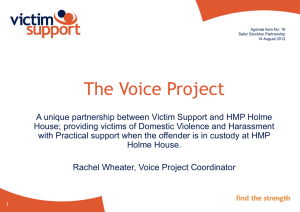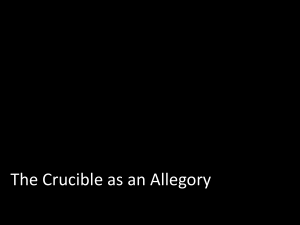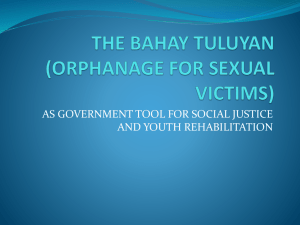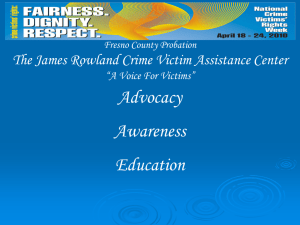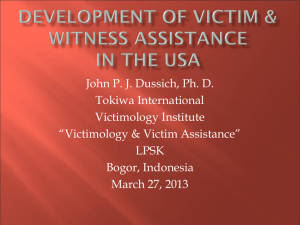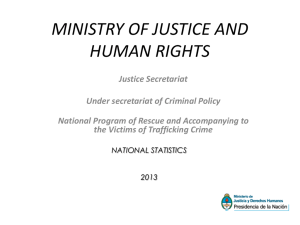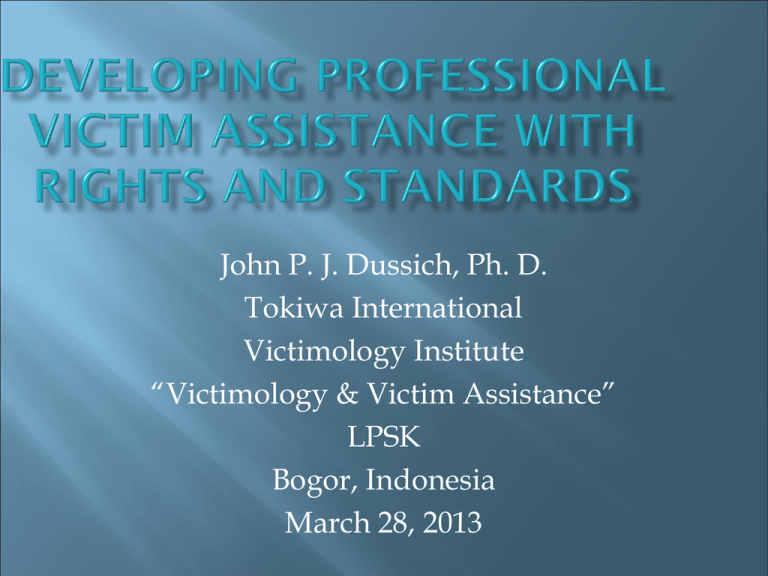
John P. J. Dussich, Ph. D.
Tokiwa International
Victimology Institute
“Victimology & Victim Assistance”
LPSK
Bogor, Indonesia
March 28, 2013
The Beginnings of Professional
Victim Assistance
Persons victimized by crime often reach out
for help to those most like themselves (i.e.
other crime victims).
In most countries victim assistance groups
started out primarily as support services and,
along with other similar groups, became an
organized voice for social change.
The Importance of Early Public
Awareness & Support
Public
demonstrations.
Public education through
written and online
information and programs.
Professional education &
training: academies, inservice, conferences & on
the job.
Community meetings.
The Role of Victims’
Rights as an Early Goal
New laws as a rallying
activity toward legitimacy.
Evolution of specific “victims’
laws” enable starting small.
Legislating new laws draws
attention and support.
Laws mandate needed actions &
become “stepping stones” for
the future.
The Final Challenge
for Victims’ Rights
In spite of a large body of new victim laws,
many are not being upheld and most nations
have still not enacted fundamental
participatory reforms such as:
Consultation with prosecutors, victim input in pretrial release, protection of victims from intimidation
and harm, and rights for victims of juvenile
offenders
Victims still need “legal standing” so that judges
uphold the prosecution of violators of these rights.
The US Experience Shows How the
Synergy of Victims’ Rights, Policies
& Programs Led to Success
1965 – A new law created 1st crime victim
compensation program in California
1968 – Omnibus Crime & Safe Streets Act
1972 – First 3 victim assistance programs
were created
1974 – First law enforcement-based victim
assistance programs are established (victim
advocate) in Florida
The US Experience continues…
1975 – First “Victims’ Rights Week”
is organized by the Philadelphia DA
1976 – National Organization for
Victim Assistance (NOVA)
1979 – Frank Carrington (“father of
victims’ rights movement”) founded
VALOR
1980 – MADD is founded & changed
many laws related to drunk driving
The US Experience continues…
1981 – Ronald Reagan is first President to
proclaim “Crime Victims’ Rights Week” in
April
1982 – President’sTask Force on Victims of
Crime offers 68 recommendations that
become the framework for new programs
& policies; recommend amending the 6th
Amendment of the U.S. Constitution
The US Experience continues…
1982 – California passes Proposition 8
which guarantees restitution to victims
1982 – MADD’s First Victim Impact Panel
1982 – OVC is created in Wash. D.C.
1984 – Passage of VOCA law
1984 – CSUF launches first Victim Services
Certificate Program
The US Experience continues…
1985 – National Victim Center is founded
in honor of Sunny von Bulow
1985 – UN General Assembly passes the
Declaration of Basic Principles of Justice
for Victims of Crime and Abuse of Power
1991 – CSUF approves first Bachelor’s
Degree Program in Criminology with a
Victimology option in the nation
The US Experience continues…
1992 – Rape in America: A
Report to the Nation by the
National Crime Victims Research
and Treatment Center
(Charleston, SC authored by
Dean Kilpatrick, et al.)
1996 – Community Notification
Act to register sex offenders
(“Megan’s Law”)
Recommendations & Standards
Based on the collective wisdom of experts
in the field and organizations throughout
the USA, comprehensive commendations
were made that include the achievement
of national standards for professional
victim assistance. These were embodied in
a publication: New Directions from the
Field: Victim Rights and Services for
the 21st Century, May 1998.
Recommendation from the Field
for Victims’ Rights
1.
Constitution should be amended to:
Establish consistent rights for victims in every state and at the federal
level
Ensure that courts balance the rights of victims and defendants
Guarantee victims the right to participate in proceedings
Enhance the participation of victims in the criminal justice process
An amendment may be the only legal measure strong enough to ensure
that the rights of victims are fully enforced
Recommendation from the Field
for Victims’ Rights
2.
3.
Victims should have the right to be notified about public court
proceedings in a timely fashion.
Many victims are not informed of plea agreements
Notification of victims when defendants are released from custody –
this can mean the difference between life and death for some victims
and their families
Victims should have the right to be present
throughout all public court proceedings
Issue of sequestering victims because they
are potential witnesses
This is a fundamental right
Recommendation from the Field
for Victims’ Rights
4.
5.
6.
Meaningful consultation with prosecutors before major case
decisions
A lack of communication about proposed plea agreement continues
to be the highest source of victim dissatisfaction
The right to be heard in major court proceedings
The right to reasonable protection
Protection from intimidation, harassment, and
retaliation by offenders
Mandated “no contact” orders as a condition
of
bail
Separate waiting areas for victims in the
courthouse
Recommendation from the Field
for Victims’ Rights
Mandatory full restitution for crime victims
1996 – Mandatory Victim Restitution Act
8. Right to disposition of proceedings free from
unreasonable delay
Ensures speedy trials for victims too, not just offenders
9. Right to a full range of services and support for recovery
Regardless of whether the crime is reported, victim should
have emergency and ongoing services
10. Victims should have the same fundamental rights in
juvenile justice proceedings
7.
Recommendation from the Field
for Victims’ Rights
All agencies should help ensure that victims receive
information about their rights
12. Victims should receive assistance in exercising their
participatory rights
13. States should review victims’ rights
statutes and constitutional amendments
14. States should adopt truth in
sentencing reforms
Victims, as well as the public, are
entitled to know how long the offender
will actually be incarcerated
11.
Recommendation from the Field
for Victims’ Rights
Laws should prohibit employers from taking adverse
action against victims who must miss work
Victims should, at minimum, have the same protection as
jury members
16. In relevant situations, victims should have the right to be
tested and to have the accused
tested for the HIV virus and
sexually transmitted diseases
17. Laws should allow agencies to
facilitate community impact
statements
15.
Recommendation from the Field
for Victims’ Rights
18.
19.
20.
21.
Victims should be able to enforce their
rights, and sanctions should be applied
to those who deny those rights
Compliance enforcement programs,
sometimes called victim ombudsman
programs, should be created
Federal crime victims’ rights should
apply to military proceedings
Indian tribes should enhance their
fundamental rights for Native American
victims
Recommendation from the Field
for Victims’ Rights
22.
23.
24.
25.
Victims should have rights at administrative
proceedings, including having someone accompany them,
the right to input, and the right to notification of the
sanction
Criminal justice agencies should monitor
their own compliance with victims’ rights
law and perform independent audits
Offer continued education for
professionals regarding victims’ right,
needs, and services
The development of new funding
Conclusions: Synergy in Action
Professional victim assistance has been
and should be lead by victims’ rights laws and
by recommendations from practices in the field.
Although these 25 recommendations were
created just over a decade ago, they are still
valid and are still being followed today.
They represent high national standards in
the service to crime victims who also
deserve a “seat at the table of justice.”
Terima kasih

